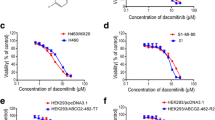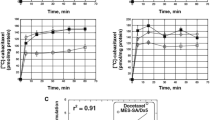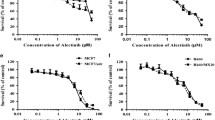Abstract
Purpose: The ATP-binding cassette transporters P-glycoprotein (Pgp) and BCRP are implicated in multidrug resistance (MDR) of many tumors. Multi-targeted inhibitors such as cyclosporin A, have been shown to circumvent MDR in clinical trials. Here, we present the characterization of a novel class of effective and multi-targeted tetrahydroisoquinolin-ethyl-phenylamine based MDR inhibitors. Methods: The novel MDR inhibitors, XR9577, WK-X-34, WK-X-50 and WK-X-84 were examined for cellular toxicity in several cell lines. Chemosensitivity and inhibition of BCRP-mediated mitoxantrone efflux were analyzed in BCRP-overexpressing MCF7/mx cells. Chemosensitivity towards daunorubicin and inhibition of Pgp-mediated efflux of 99mTc-Sestamibi were examined in Pgp-overexpressing A2780/Adr cells. Potential MRP-interactions were evaluated with 5-CFDA efflux assays in selectively transfected MRP-1, -2 and -3 cell lines. Results: All WK-X-compounds showed significant BCRP inhibition in the MCF7/mx cells resulting in significant increases in mitoxantrone intracellular accumulation and 200–300 fold increases in mitroxantrone cytotoxicity. WK-X-34 and XR9577 were also potent inhibitors of Pgp, increasing 99mTc-Sestamibi accumulation with IC50 values in the nM range. Daunorubicin cytotoxicity was also increased seven to eight-fold in cells co-treated with XR9577 or WK-X-34 (10 μM). These compounds did not appear to interact with the MRP transporters. As compared to cyclosporin A, these compounds showed reduced cellular toxicity and increased potency of BCRP and Pgp inhibition. Conclusion: The novel MDR inhibitors WK-X-34 and XR9577 demonstrate superior effectiveness in Pgp and BCRP inhibition, in vitro tolerance and specificity over cyclosporin A. The novel compounds might be the promising candidates for a broad-spectrum based approach to the circumvention of MDR in resistant tumors.






Similar content being viewed by others
Abbreviations
- MDR:
-
Multidrug resistance
- ABC:
-
ATP-binding cassette
- Pgp:
-
P-glycoprotein
- BCRP:
-
Breast cancer resistance protein
- MRP:
-
Multidrug-resistance associated protein
- LRP:
-
Lung resistance protein
- FITC:
-
Fluorescein isothiocyanate
- MTT:
-
Methylthiazolyldiphenyl-tetrazoliumbromide
References
Allen AD, Schinkel AH (2002) Multidrug resistance and pharmacological protection mediated by the breast cancer resistance protein (BCRP/ABCG2). Mol Cancer Ther 1:427–434
Bates SE, Robey R, Miyake K, Ross DD, Litman T (2001) The role of half-transporter in multidrug resistance. J Bioenerg Biomembr 33:503–511
Borst P, Evers R, Kool M, Wijnholds J (2000) A family of drug transporters: the multidrug resistance-associated proteins. J Natl Cancer Inst 92:1295–1302
Brooks T, Minderman H, O’Loughlin KL et al (2003) Taxane-based reversal agents modulate drug resistance mediated by P-glycoprotein, multidrug resistance protein, and breast cancer resistance protein. Mol Cancer Ther 2:1195–1205
Calne RY, Rolles K, Thiru S et al (1979) Cyclosporin A initially as the only immunosuppressant in 34 recipients of cadaveric organs: 32 kidneys, 2 pancreases and 2 livers. Lancet 2:1033–1036
Dale IL, Tuffley W, Callaghan R et al (1998) Reversal of P-glycoprotein-mediated multidrug resistance by XR9051, a novel diketopiperazine derivative. Br J Cancer 78:885–892
Dalton WS, Grogan TM, Meltzer PS et al (1989) Drug-resistance in a multiple myeloma and non-Hodgkin’s lymphoma: detection of p-glycoprotein and potential circumvention by addition of verapamil to chemotherapy. J Clin Oncol 7:415–424
Damiani D, Michieli M, Ermacora A et al (1998) P-glycoprotein (PGP) and not lung resistance-related protein (LRP), is a negative prognostic factor in secondary leukemias. Haematologica 83:290–297
Dean M, Jojo T, Bates S (2005) Tumor stem cells and drug resistance. Nature Reviews Cancer 5:275–284
Doyle LA, Ross DD (2003) Multidrug resistance mediated by the breast cancer resistance protein BCRP (ABCG2). Oncogene 22:7340–7358
Filipits M, Suchomel RW, Zochbauer S et al (1997) Multidrug resistance-associated protein in acute myeloid leukemia: no impact on treatment outcome. Clin Cancer Res 3:1419–1425
Fojo AT, Ueda K, Slamon DJ, Poplack DG, Gottesman MM, Pastan I (1987) Expression of a multidrug-resistance gene in human tumors and tissues. Proc Natl Acad Sci USA 84:265–269
Gijtenbeek JM, Van den Bent MJ, Vecht CJ (1999) Cyclosporin neurotoxicity: A review. J Neurol 246:339–334
Hyafil F, Vergely C, Du Vignaud P, Grand-Perret T (1993) In vitro and in vivo reversal of multidrug resistance by GF120918, an acridonecarboxamide derivative. Cancer Res 53:4595–4602
Jekerle V, Klinkhammer W, Scollard DA, Breitbach K, Reilly RM, Piquette-Miller M, Wiese M. In vitro and in vivo evaluation of WK-X-34, a novel inhibitor of P-glycoprotein and BCRP using radio imaging techniques Int J Cancer (in press)
Krishna R, Mayer LD (2000) Multidrug resistance (MDR) in cancer Mechanisms, reversal using modulators of MDR and the role of modulators in influencing the pharmacokinetics of anticancer drugs. Eur J Pharm Sci 11:265–283
Kruh GD, Belinsky MG (2003) The MRP family of drug efflux pumps. Oncogene 22:7537–7552
Lee G, Piquette-Miller M (2001) Influence of IL-6 on MDR- and MRP-mediated multidrug resistance in human hepatoma cells. Can J Physiol Pharmacol 79:876–884
Ling V (1995) P-glycoprotein:its role in drug resistance. Am J Med 99:31–34
List AF, Kopecky KJ, Willman CL et al (2001) Benefit of cyclosporin modulation of drug resistance in patients with poor-risk acute myeloid leukemia: a Southwest Oncology Group study. Blood 98:3212–3220
Menefee ME, Fan C, Edgerly M, Draper D, Chen C, Robey R, Balis F, Figg WD, Bates S, Fojo AT (2001) Tariquidar (XR9576) is a potent and effective P-glycoprotein (Pgp) inhibitor that can be administered safely with chemotherapy. J Clin Oncol, 2005 ASCO Annual Meeting Proceedings 23(16S):3093
Minderman H, Suvannasankha A, O’Loughlin KL et al (2002) Flow Cytometry Analysis of Breast Cancer Resistance Protein Expression and Function. Cytometry 48:59–65
Mistry P, Stewart AJ, Dangerfield W, Okiji S, Liddle C, Bootle C, Plumb JA, Templeton D, Charlton P (2001) In vitro and in vivo reversal of P-glycoprotein-mediated multidrug resistance by a novel potent modulator, XR9576. Cancer Res 61(2):749–758
Muzzammil T, Moore MJ, Hedley D, Ballinger JR (2001) Comparison of 99mTc-Sestamibi and doxorubicin to monitor inhibition of P-glycoprotein function. Brit J Cancer 84:367–373
Oza AM (2002) Clinical development of P-glycoprotein modulators in oncology. Novartis Found Symp 243:103–115
Pajeva IK, Globisch C, Wiese M (2004) Structure-functions relationships of multidrug resistant P-glycoprotein. J Med Chem 47:2523–2533
Qadir M, O’Loughlin KL, Fricke SM et al (2005) Cyclosporin A is a broad-spectrum multidrug resistance modular. Clin Cancer Res 11:2320–2326
Raaijmakers MH, De Grouw EP, Heuver LH et al (2005) Breast cancer resistance protein in drug resistance of primitive CD34 + 38- cells in acute myeloid leukemia. Clin Cancer Res 11:2436–2444
Roe M, Folkes A, Ashworth P et al (1999) Reversal of P-glycoprotein mediated multidrug resistance by novel anthranilamide derivatives. Bioorg Med Chem Let 9:595–600
Ross DD (2000) Novel mechanisms of drug-resistance in leukemia. Leukemia 14:467–473
Ross DD (2004) Modulation of drug resistance transporters as a strategy for treating myelodysplastic syndrome. Best Pract Res Clin Heamatol 4:641–651
Smeets M, Raymakers R, Muus P et al (2001) Cyclosporin increases cellular idarubicin and idarubicinol concentrations in relapsed or refractory AML mainly due to reduced systemic clearance. Leukemia 15:80–81
Tsuruo T, Lida H, Nojiri M, Tsukagoshi S, Sakurai Z (1981) Overcoming of vincristine resistance in P388 leukemia in vivo and in vitro through enhanced cytotoxicity of vincristine and vinblastine by verapamil. Cancer Res 41:1967–1972
Urasaki Y, Ueda T, Yoshida A et al (1996) Establishment of daunorubicin-resistant cell line which shows multi-drug resistance by multifactorial mechanisms. Anticancer Res 16:709–714
Utsunomiya K, Ballinger JR, Piquette-Miller M et al (2000) Comparison of the accumulation and efflux kinetics of technetium-99m sestamibi and technetium-99m tetrofosmin in an MRP- expressing tumour cell line. Eur J Nucl Med 27:1786–1792
Yang CH, Chen YC, Kuo ML (2003) Novobiocin sensitizes BCRP/MXR/ABCP overexpressing topotecan-resistant human breast carcinoma cells to topotecan and mitoxantrone. Anticancer Res 23:2519–2523
Acknowledgements
This research was supported by the Deutsche Forschungsgemeinschaft (DFG, Graduiertenkolleg 804, VJ), the Canadian Institute of Health Research Grant (MPM) and the Government of Canada Award (VJ). The authors wish to thank Jing-Hung Wang for excellent technical assistance with the transport assays and Shaun Ramdhany and the Department of Nuclear Cardiology, UHN, Toronto for providing the 99mTc-Sestamibi.
Author information
Authors and Affiliations
Corresponding author
Rights and permissions
About this article
Cite this article
Jekerle, V., Klinkhammer, W., Reilly, R.M. et al. Novel tetrahydroisoquinolin-ethyl-phenylamine based multidrug resistance inhibitors with broad-spectrum modulating properties. Cancer Chemother Pharmacol 59, 61–69 (2007). https://doi.org/10.1007/s00280-006-0244-3
Received:
Accepted:
Published:
Issue Date:
DOI: https://doi.org/10.1007/s00280-006-0244-3




